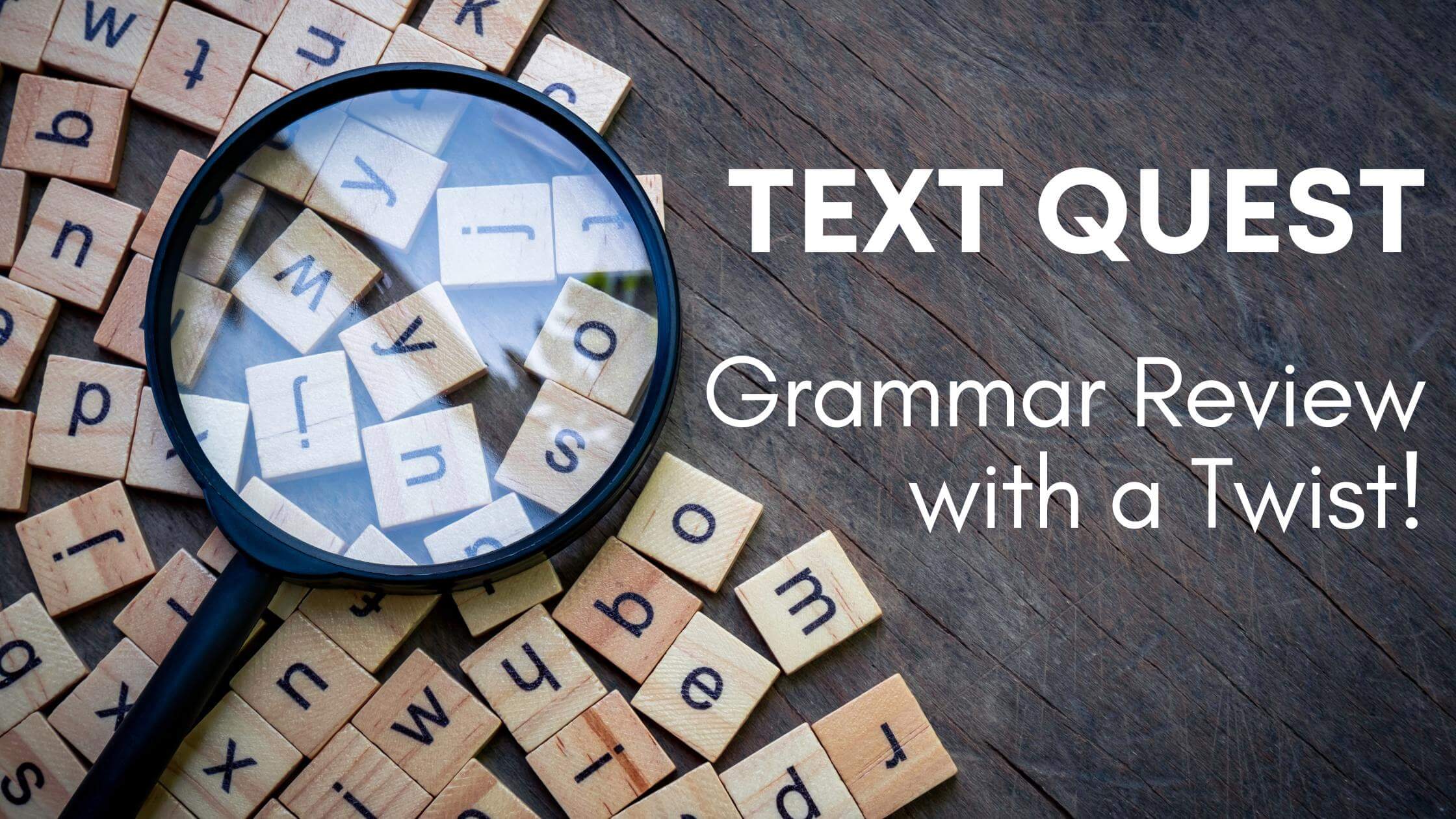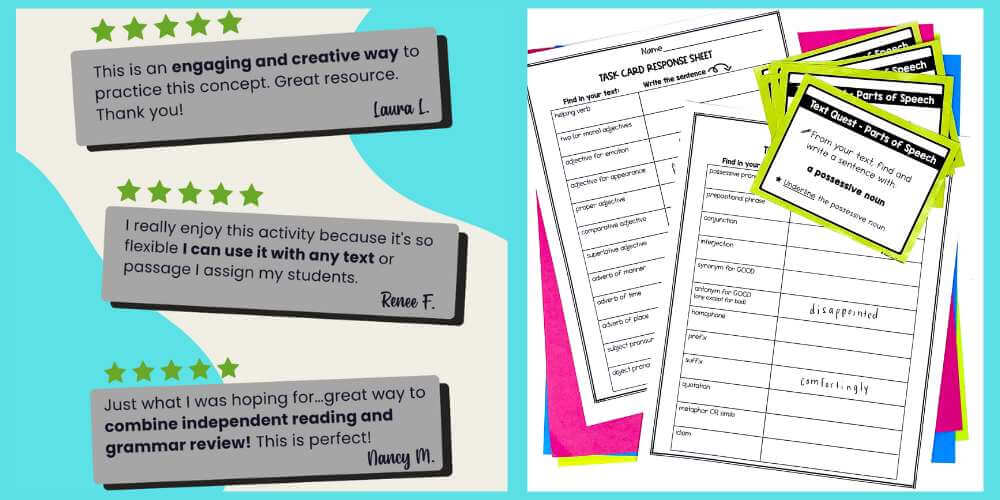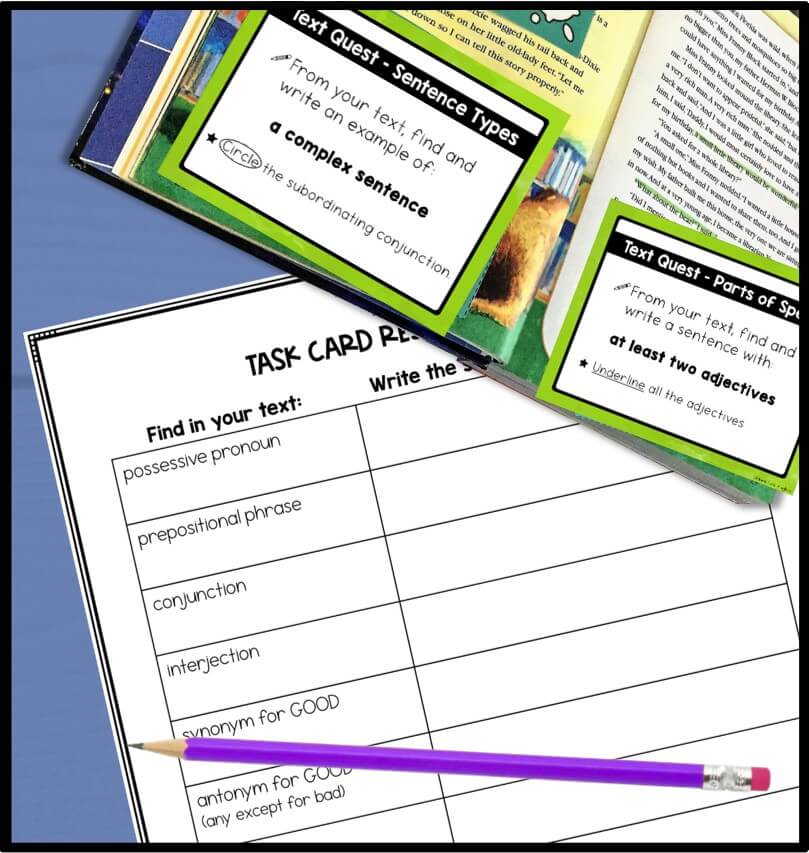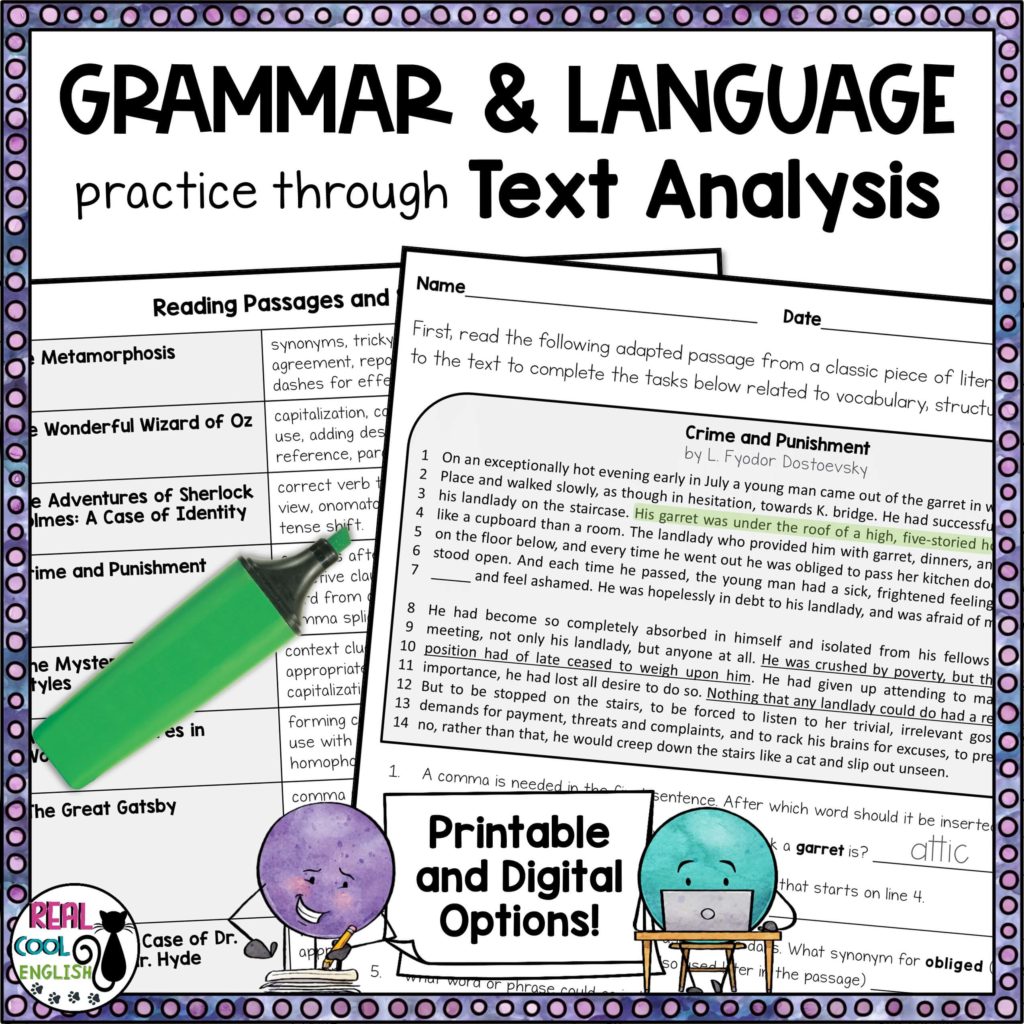
I am, admittedly, a bit of a grammar nerd. I think it’s interesting to think about and discuss different grammar patterns and sentence structures. While I may find it fun to teach, I am aware that not everyone shares my fondness for all things grammar. Students, in particular, find it boring and they dread the tedious grammar practice.
I totally get that, so my goal is to help them understand how language works, not just to follow grammar rules. I firmly believe the best way to do this is by first noticing the language around them.
What if instead of just giving them worksheets with the usual practice activities, we gave them a way to be more actively involved using authentic materials?
A grammar scavenger hunt, or text quest, gamifies the process, making it much more engaging. Plus, this student-centered approach encourages deeper understanding, meaning the concepts are more likely to stick!
How the Text Quest Works
Select any short text and create a list of items for students to discover examples found within the text. Some ideas of the types of examples to look for:
- Parts of speech
- An interrogative sentence (or imperative, etc.)
- A compound or complex sentence
- A comparative or superlative adjective
- A metaphor or simile
- Or whatever grammar or language points you want to focus on
One thing I love about this text quest activity is that it encourages students to stop and think about what each of those concepts means. Before they can look for a complex sentence, for example, they have to be sure they understand what a complex sentence actually is.
When students independently think about and discover the patterns, they tend to develop a much stronger grasp of the concepts.
A Versatile Grammar Review Activity
This text quest could be used as a short bell ringer activity or for any time you want to squeeze in a quick review. Just give students 1 or 2 grammar points to identify in a text you are working with. As a quick extension activity, I love having students share the different answers they found for the same question using the same text. It’s a great way for students to get even more exposure to examples of a particular grammar concept.
If you want to spend a little more time with this, you could also make it a longer activity, where they need to identify multiple grammatical or language structures. And it’s perfect for either an individual or partner/small group activity!
Not sure how to get started with this activity in your classroom?
This Grammar Review Text Quest has everything you need to get your students engaged in the process – all you need to do is just add any text!
You can choose to present the activity in two ways. First, with each grammar point on individual cards, making it perfect for a bell ringer or other quick review activity. Second, with worksheets that contain 6 tasks. You can even try out a free sample worksheet.
For even more flexibility, you also have the option to customize the worksheet so that you can choose specific points to work with to make it relevant for a specific topic or text.
See what teachers are saying about this Text Quest activity!

What I love best about this resource is that you can make it an all-year review and reference activity. It includes recording sheets that students fill in as they find specific examples of each grammar point. Once completed, they can refer to it all year long to take more control of their own learning.
Have you ever mentioned a grammar concept, such as a complex sentence, and your students respond, “What is that?” With this handy reference guide, students can look back at their selected sentence to see an authentic example. This is another way to reinforce their understanding and help them remember the concept.
Text Quest Ideas for Advanced Levels or Upper Grades
You could also take this idea one step further. Instead of having students just identify specific concepts within a text, you could also have them work creatively with the given text. Some ideas for tasks:
- Choose X number of words and replace them with appropriate synonyms
- Find two sentences that you could combine into one
- Find a compound sentence and rewrite it so that it is a complex sentence
- Paraphrase a sentence in the text
- Find a quote and change it to reported speech (or vice versa)
Ready to Go Text Quest Activities for Upper Grades
For upper levels (high school and Advanced Adult ESL classes), I created bite-sized reading passages with grammar and language text quest tasks. With these print and go (or paperless), you don’t even need to provide the text. These activities include passages selected and adapted from classic literature.
With this text quest, students will be working with more advanced grammar and language concepts in addition to identifying specific language examples.
Some examples that they may need to find scavenger hunt style:
- run-on sentences
- punctuation errors
- misspelled homophones
- pronoun antecedents
- figurative language and poetic devices, such as similes, metaphors, idioms, onomatopoeia, etc.
Students will also dig a little deeper into the text with other tasks that get them thinking about why a particular grammar structure was used, such as:
- Why the author made a particular vocabulary or structure choice
- Why a particular punctuation mark or capitalization is needed in a given sentence
- A word or phrase that might be different in a more modern text
They will also have opportunities to work with the text to make necessary revisions or propose alternative structures, such as:
- Identifying and revising a sentence that is not parallel
- Identifying and correcting inappropriate tense shift
- Rewriting passive sentences into active voice
Students will also encounter activities for determining meaning from context clues and paraphrasing sentences.
Why Classic Literature?
A passage from classic literature is perfect for these activities because of the nature of the language that is often found in older texts. There are often words that were used commonly at the time, but are very rare now, making it an authentic activity to discover meaning from context.
Paraphrasing is such an important skill that is often overlooked until much later, so I love finding opportunities to sprinkle in practice early on. Again, classic literature provides the perfect opportunity to hone this skill. The language is often outdated and flowery, so it’s a good exercise to reword a short passage into simple, everyday language. It also encourages students to read carefully to make sure they actually understand what they are reading.
Try Text Analysis Activities with Your Upper Level Students!
With Grammar and Language Through Text Analysis, you’ll get an assortment of high-interest passages from classic literature, such as Alice in Wonderland, Dracula, The Wizard of Oz, The Great Gatsby, and more! You can try out a free lesson using a passage from The Circular Staircase by Mary Roberts Rinehart.
These text analysis activities are short, but packed with activities to get students noticing language and thinking critically and creatively. Use them as individual or partner work – as early finisher activities or whenever you have a little extra time and you want to squeeze in some grammar practice.
I love to have a short discussion afterwards to talk about different solutions or fill in any gaps. It’s a great way to identify specific areas where you may want to provide additional practice.
For even more versatility, you’ll get options for print-and-go one-page activity sheets or a paperless version.
I hope you have found lots of ideas for using authentic texts as a way to incorporate grammar and language practice into your classroom routine. I’d love to hear how it worked for you!

